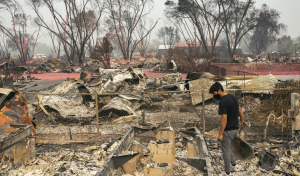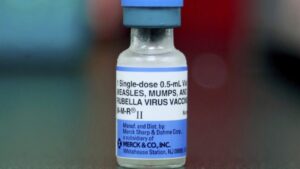The march, which was held on July 2, led protestors throughout downtown East St. Louis, undeterred by the rain.Multimedia Editor Damian Morris
On a rainy Saturday in East St. Louis, protestors took to the streets, calling for reparations to be paid for the damages done 151 year ago throughout the city.
Labor violence, racism comes to a head in 1917 East St. Louis
In the early 1910s the city of East St. Louis’ Black population nearly doubled from around 6,000 to 12,000, according to Smithsonian Magazine. This was part of what many historians call The Great Migration. From the early 1900s until the ‘70s, approximately 6 million Black Americans in the South moved states further north or west in an attempt to find a better life for themselves and their families.
In many cases, however, the Black Americans were met with very similar circumstances from which they had fled. East St. Louis in 1917 was an example of this.
Smithsonian Magazine reports that in late 1916 and early 1917, hundreds of white workers in East St. Louis went on strike to protest for higher wages. However, since a large population of Black Americans in East St. Louis who had recently moved in, the owners of the factories fired almost all of the white workers on strike. Those positions were then filled by Black workers who were paid less than their white counterparts.
At a city council meeting on May 28, 1917, white workers registered formal complaints against the Black population of East St. Louis. Later in June, a mob attacked the Black neighborhoods of East St. Louis, pulling Black people off of streetcars and trolleys. The National Guard were called, though they were impartial to the violence at first.
After the initial violence subsided, a group of white men drove their black Model-T Ford through a predominantly Black neighborhood and shot out of the car into homes on July 1. The Black people in that neighborhood organized themselves to prepare for another attack. Later that day, another black Ford drove down the same street, prompting the Black citizens to fire their own guns at it, thinking it was the previous car. Two police officers were driving that car, and both of them died.
The next day, an even larger mob descended on the Black neighborhoods of East St. Louis. Black homes were burned down, children were killed and there was even an organized effort in the city of St. Louis for Black refugees to cross the Eads Bridge and escape into the city. Some refugees, however, had to swim across the Mississippi River to escape.
The official reported death toll, after full days of riots in East St. Louis, was 39 Black Americans and nine white. However, many believe the correct total of Black deaths was in the hundreds.
“Reparations now!”: Several local organizations fight for remembrance and reimbursement
Julian Johnson, co-founder of local activist group Empire 13, was present at the march on July 2, exactly 151 years after the riots. Empire 13 was one of the groups that helped organize the protest.
“Years later, today, we are marching for reparations and calling for back pay for what we need, what we are owed,” Johnson said. “If it weren’t for the horrible events of that day, so much would be different here. Land would be owned by different people, different businesses could have been built up and could maybe have even still been here now. A lot of legacies were basically cut short.”
Larita Rice-Barnes, executive director of the Metro East Organizing Coalition, said the only criminal trial that ever came to pass regarding the East St. Louis riots was the trial of Leroy Bundy. Although many white men were sent to trial and imprisoned for the riot, Bundy, a Black man, was found by an all-white jury to be the instigator of the riot.
“Leroy Bundy was prosecuted, and his home and all of it was destroyed right here on the grounds of East St. Louis,” Rice-Barnes said. “That could have been a home for his grandkids and great-grandkids to have today, but our city is still suffering with dilapidated buildings, vacant lots from those buildings that were destroyed and so we just want to make sure that the people, the children that are here, are able to benefit off of what their ancestries and ancestors did and what they went through.”
East St. Louis Mayor Robert Eastern III spoke to the crowd after the march. He said this was the second year they had held this protest, and the community will continue to hold this protest annually until reparations are paid.
“We always need a lot of people, we always need a lot of voices,” Eastern said. “So don’t be deterred by the rain, or the sun. Last year, it was so hot. This year, it’s rain. It’s probably going to snow next year. But we’re going to keep pushing until we get our reparations, no matter what.”
Both before and after the march, JD Dixon, co-founder of Empire 13, addressed his fellow marchers about the importance of local activist groups and protests like this one. Dixon specifically cited the work of Rev. Martin Luther King Jr.
“[King] knew. He saw the only way to eliminate poverty in the Black community today is to pay the millions of dollars back that Black Americans are owed,” Dixon said. “The tragedy that happened here in 1917 is one thing, but we also deserve pay for the unpaid labor of our ancestors for four hundred years.”
Eastern said the purpose of the protest is not a complex one and should be brought to more attention.
“People say, ‘What exactly are you fighting for?’ We’re fighting for freedom, freedom to live our lives as they should be if that awful day didn’t happen,” Eastern said. “What else is there to even say? We can’t go back and change what happened, but we can change the future. I can’t do that all by myself, nobody can, but that’s what we’re all out here for.”
Rice-Barnes said protests and marches like this are important to any community in the U.S. or even the world, but the real importance and power comes from local activists organizing themselves together.
“The importance [of a group like MEOC] is we raise attention to issues that affect those who are marginalized, and letting them know that they are not alone. We stand in solidarity with them,” Rice-Barnes said. “We need to be on-the-ground with them and be with them as a voice for justice and peace and righteousness.”
For more information, visit the Facebook pages of Empire 13 and of the MEOC.




